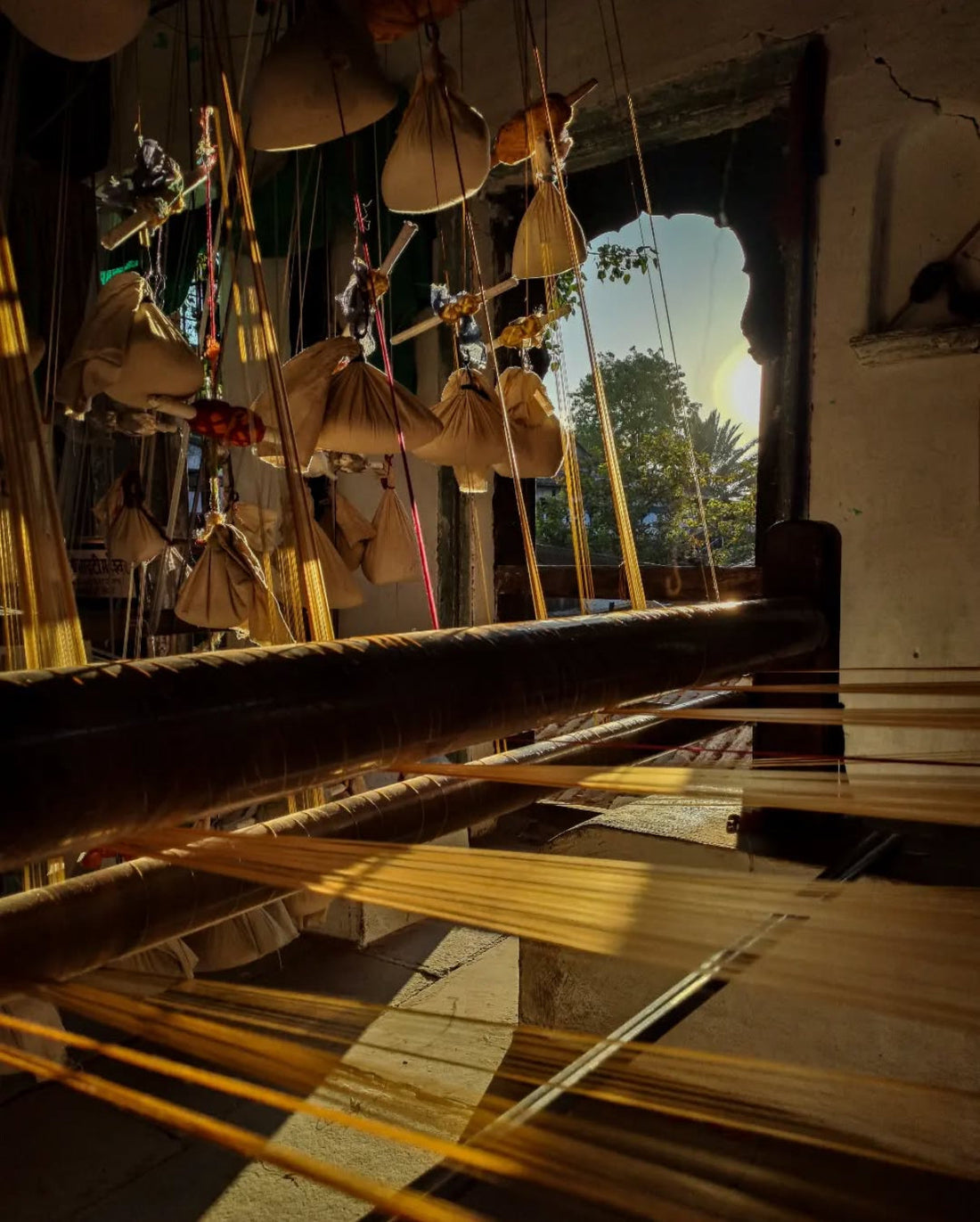
The Art of Handloom Weaving: Behind the Scenes at Maaheshwari
Share
Handloom weaving is more than just a craft; it is a legacy passed down through generations, preserving the essence of tradition, skill, and patience. Among India’s most revered handwoven sarees, Maheshwari sarees stand out for their exquisite designs, lightweight fabric, and regal elegance. But have you ever wondered what goes into creating these masterpieces?
In this blog, we’ll take you on a behind-the-scenes journey into the intricate art of handloom weaving at Maheshwar, Madhya Pradesh. From selecting the finest yarn to the final finishing touches, let’s explore the craftsmanship and dedication of the weavers who bring Maheshwari sarees to life.
1. Sourcing & Preparing the Yarn: The Foundation of Weaving
Every Maheshwari saree begins with the careful selection of fine silk and cotton yarns. Traditionally, these sarees are woven using a silk warp and cotton weft, giving them their unique lightweight yet lustrous texture.
The Yarn Preparation Process:
🔹 Dyeing – The yarns are dyed in rich, vibrant colors using either natural or chemical dyes. Artisans ensure even color distribution for a flawless finish.
🔹 Drying – The dyed threads are dried under natural sunlight, enhancing the depth and richness of the colors.
🔹 Warping – The yarns are stretched out in long parallel lines on a warping frame to ensure uniform tension before they are loaded onto the loom.
📌 Fun Fact: The colors of Maheshwari sarees are often inspired by the natural beauty of Maheshwar—deep reds, greens, blues, and golds reflecting the town’s heritage.
2. Setting Up the Loom: Preparing for Weaving
Once the yarn is prepped, it is mounted onto a traditional handloom, a wooden structure where the magic of weaving happens. This process requires immense precision and patience.
Key Steps in Loom Setup:
✅ Threading the Warp – The silk threads are carefully arranged on the loom, ensuring the proper alignment of the saree’s design.
✅ Tying the Weft – The cotton weft threads are wound onto bobbins, which are then inserted into the shuttle for weaving.
✅ Tension Adjustment – The artisans meticulously adjust the tension of the threads, ensuring smooth and even weaving.
📌 Did You Know? A single loom can take 2-3 days just to be set up before the actual weaving process begins!
3. Weaving: The Heart of Handloom Craftsmanship
Weaving a Maheshwari saree is a meticulous and time-consuming process, requiring skilled artisans who have mastered the art over years of practice. The handloom weaving technique involves interlacing the warp and weft threads manually to create intricate patterns.
Unique Weaving Techniques of Maheshwari Sarees:
🧵 Reversible Borders (Bugdi) – A special weaving technique that allows the saree’s border to be the same on both sides.
🧵 Zari Weaving – Fine metallic threads are woven into the fabric to create traditional gold and silver designs.
🧵 Motif Creation – Using wooden dobby and jacquard looms, artisans weave beautiful motifs like chatai (mat), eent (brick), and leheriya (waves), inspired by Maheshwar’s architecture.
📌 Time Taken: A single Maheshwari saree can take anywhere from 3 to 7 days to weave, depending on its complexity.
4. Finishing Touches: Perfecting the Saree
Once the weaving is complete, the saree undergoes several finishing steps to ensure its durability and finesse.
Final Processing Includes:
✨ Cutting & Edge Reinforcement – Loose threads are neatly trimmed, and the edges are secured for durability.
✨ Washing & Polishing – The saree is washed to remove any residual dyes and polished to enhance its natural sheen.
✨ Ironing & Folding – Finally, the saree is carefully ironed and folded, ready to be sold or worn.
📌 Fun Fact: The traditional Maheshwari saree is 6 yards long and has a distinctive pallu with five stripes, a signature feature of its design.
5. The Weavers: The Soul Behind Maheshwari Sarees
The artisans of Maheshwar are the true custodians of this ancient craft. Many belong to families that have been weaving for hundreds of years, keeping the tradition alive despite modernization challenges.
Why Handloom Weaving Matters:
💖 Sustains Livelihoods – The handloom industry provides employment to thousands of artisans, especially women.
💖 Preserves Heritage – Each saree is a reflection of India’s rich textile legacy.
💖 Promotes Sustainability – Handloom weaving is eco-friendly, requiring no electricity and using minimal resources.
📌 Did You Know? Rani Ahilyabai Holkar, the Queen of Malwa, played a pivotal role in promoting Maheshwari sarees in the 18th century.
6. Why Handwoven Maheshwari Sarees Are Special
Unlike machine-made textiles, handwoven sarees are one-of-a-kind, carrying the personal touch of the artisan who weaves them. When you wear a Maheshwari saree, you’re not just wearing fabric—you’re wearing history, culture, and the dedication of skilled hands.
Why You Should Own a Maheshwari Saree:
✅ Lightweight & Comfortable – Perfect for all occasions.
✅ Timeless Elegance – A fashion statement that never goes out of style.
✅ Sustainable & Ethical – Supports artisans and eco-friendly fashion.
✅ Heirloom Quality – Can be passed down through generations.
📌 Pro Tip: When purchasing a Maheshwari saree, look for authentic handloom marks to ensure its originality.
Conclusion: Weaving Stories, One Saree at a Time
The beauty of Maheshwari sarees lies not just in their intricate patterns but in the stories of craftsmanship, dedication, and tradition that they carry. Every warp and weft is a testament to the skilled artisans who keep this heritage alive.
By choosing handwoven Maheshwari sarees, you are not only embracing a piece of timeless elegance but also supporting an art form that deserves to be preserved for future generations.
So, the next time you drape a Maheshwari saree, remember—you are wearing a masterpiece woven with love and history.
Have you ever visited a handloom weaving center? Share your experience in the comments below!
